Trimming clips
Trimming a clip cuts off a portion of the clip at its start or end. To trim a clip, select the Mix mode as the Clip Edit mode, then drag the start or end of the clip. Dragging the start or end of a clip automatically selects the clip, showing its properties in the InspectorA Unity window that displays information about the currently selected GameObject, Asset or Project Settings, allowing you to inspect and edit the values. More info
See in Glossary window. Use the Clip Timing properties in the Inspector window to set the start, end, duration, and offset (Clip In) of a clip to exact values.
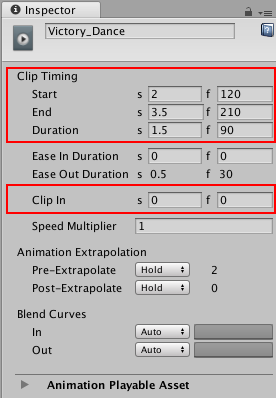
Trimming the start of a clip
Trimming an Animation clipAnimation data that can be used for animated characters or simple animations. It is a simple “unit” piece of motion, such as (one specific instance of) “Idle”, “Walk” or “Run”. More info
See in Glossary or Audio clipA container for audio data in Unity. Unity supports mono, stereo and multichannel audio assets (up to eight channels). Unity can import .aif, .wav, .mp3, and .ogg audio file format, and .xm, .mod, .it, and .s3m tracker module formats. More info
See in Glossary after the start of the Source AssetAny media or data that can be used in your game or Project. An asset may come from a file created outside of Unity, such as a 3D model, an audio file or an image. You can also create some asset types in Unity, such as an Animator Controller, an Audio Mixer or a Render Texture. More info
See in Glossary, selects the part of the Source Asset the clip uses.

Trimming a clip is non-destructive. Trim the clip again to modify its start to include the animation, or the audio waveform, cut off during a previous trim. You can also reset a clip to undo trims or other edits.
To trim the start of a clip to a precise time or frame, use the Clip In property in the Inspector window.
Changing the Clip In property is similar to the same effect as trimming the start of a clip after the start of its Source Asset.
Trimming the end of a clip
As with the start of the clip, trimming an Animation clip or Audio clip before the end of the Source Asset, selects the part of the Source Asset the clip uses.

If you trim the end of an Animation clip or Audio clip past the end of the Source Asset the clip is based on, the extra clip area either holds or loops, depending on the settings of the Source Asset.
For example, an Animation clip named “End Move” uses the motion file “Recorded(2)” as its Source Asset. The motion file “Recorded(2)” is set to loop. Trimming the end of the Animation clip past the end of the “Recorded(2)” Source Asset fills the extra clip area by looping “Recorded(2)”. A white animation curveThe curve drawn between keys set for the same animatable property, at different frames or seconds. The position of the tangents and the selected interpolation mode for each key determines the shape of the animation curve. More info
See in Glossary shows the hold or loop.

To choose whether the extra clip area holds or loops, select the Source Asset to change its settings in the Inspector window. Depending on the type of Source Asset, different properties control whether the Source Asset holds or loops.
If you are unsure which Source Asset is used by a clip, select the clip in the Clips viewThe area in the Timeline Editor window where you add, position, and manipulate clips. More info
See in Glossary, right-click and select Find Source Asset from the context menu. This highlights the Source Asset in the Project window.
Trimming the end of looping clips
The TimelineGeneric term within Unity that refers to all features, windows, editors, and components related to creating, modifying, or reusing cut-scenes, cinematics, and game-play sequences. More info
See in Glossary window provides special trimming options for Animation clips or Audio clips with loops. These special trim options either remove the last partial loop or complete the last partial loop.
For example, the Animation clip named run_away is over three times longer than the Source Asset on which it is based. Since the Source Asset is set to loop, the Animation clip loops the Source Asset until the Animation clip ends which results in a partial loop.

To extend the end of the clip and complete a partial loop, select the clip, right-click and select Editing > Complete Last Loop. To trim the clip at the last complete loop, select the clip, Right-clip and select Editing > Trim Last Loop.
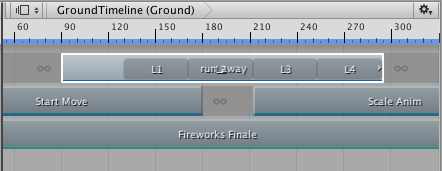
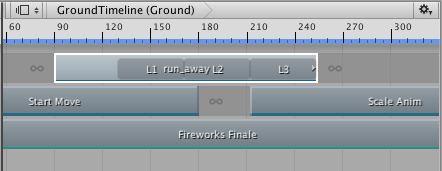
Trimming with the Timeline Playhead
You can also trim a clip based on the location of the playhead. To trim using the playhead, position the playhead within the clip to be trimmed. Right-click the clip and select either Editing > Trim Start or Editing > Trim End. Trim Start trims the start of the clip to the playhead. Trim End trims the end of the clip to the playhead.
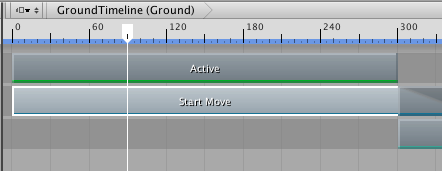
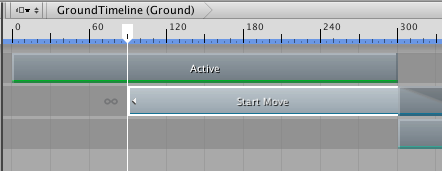
If you select clips on multiple tracks, Timeline only trims the selected clips that intersect the playhead.
- 2019–08–20 Page published